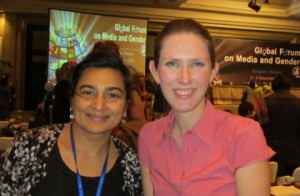The Trouble With Making Women’s Programs All About Health – A Report from the UN Global Forum on Media and Gender
“Welcome to [the program] Let’s listen to women’s voices. In this program, we will be talking to an EPI (Extended Program on Immunization) representative to tell us how they immunize women.”
So begins the women’s program on a small South Sudanese community radio station in the North of South Sudan. I listen, and am slightly surprised. I’m researching the role that radio plays in women’s empowerment, and although I wasn’t sure what to expect from the women’s program, I didn’t expect this. For half an hour I listen to a male EPI representative talk about immunization.
“For the immunization of pregnant mothers, they are immunized against tetanus, and for other diseases the hospital is divided. There is a department to test for other diseases, and there is also a department where you are asked when the disease started. For a disease that is chronic, you are asked about it, and if possible you will be given medication that will help you recover a bit so that you are able to talk and explain the problem or the disease…”
The EPI representative goes on and on. During the entire half-hour program, the female interviewer interjects only three times. This is when I realize that women’s programming and health programming get conflated. A lot.
Granted, all of the reporters at this station are learning, supported by the NGO Internews, which provides on-going training and mentoring. A few years ago there were no reporters, and no radio station.
And the dry, informational style of this particular program notwithstanding, health is undoubtedly one of the most important issues facing women in South Sudan. One in seven women die in pregnancy or childbirth.
But is the blending of women’s programming and health programming problematic in any way? I would argue, yes.
The disadvantages
I have two concerns about conflating women’s programming and health programming.
Firstly, there is more to women’s empowerment than health. Preeminent feminist scholar, Naila Kabeer, defines empowerment as, “the process by which those who have been denied the ability to make strategic life choices acquire such an ability.”
Strategic life choices undoubtedly include health choices, but they also include other choices – for example, who to marry, and whether to continue with education (both choices often denied to South Sudanese women).
Secondly, women’s health involves more than just women. When I managed research on RMNCH (reproductive, newborn, maternal and child health) for BBC Media Action, as part of a 90 million pound, five-year strategic grant from DFID, one of our key target audiences was men. This was important, because in many countries, husbands hold all of the decision-making power. They decide, for example, whether and when a woman goes to hospital.
Conflation is therefore not only problematic for women’s programming; it’s problematic for health programing.
The advantages
I got another perspective on this issue, however, at the UN Global Forum on Media and Gender, which ran from December 2nd to 4th. Manisha Aryal, author of From Counting Women to Making Women Count and former Director of Internews’ Global Human Rights program, told me how she used health to start discussions with men in Pakistan’s tribal areas about Internews-supported radio programming.
“Because it’s so uncontroversial – everyone wants their kids to be healthy, their women to be healthy – it’s a very good entry point. Especially in places where you really want to get women’s voices and reach out to women. “
For this project, health was the best way to gain access to an otherwise inaccessible group of women. And after a few years the radio program was able to branch out to other women’s topics. Another obvious advantage to covering health in women’s programming is that women in many parts of the world have primary responsibility for looking after children, so persuading them to adopt healthier behaviours can benefit family health.
What lessons for communicators?
Clearly, health needs to remain a component of women’s programming. And it can serve as an entry point to reach women in challenging contexts.
But women’s programming should not focus exclusively on health. Indeed, I’m pleased to discover, as my research proceeds, that the women’s program on the aforementioned South Sudanese community radio station covers a wide range of topics.
Ultimately, I would offer two suggestions to those producing media content:
- Producers of women’s programs should be conscious of the amount of airtime they devote to health, and not cover health exclusively.
- Producers in general should be careful not to ghettoize health as a women’s issue. Everyone needs to be concerned with the health of women, including men.








Leave a Reply
Want to join the discussion?Feel free to contribute!